Ministry of Defense (Afghanistan)
The Ministry of Defense (Dari: وزارت دفاع ملی, Wizārat-e Difā'-e Millī, Pashto: د ملي دفاع وزارت, Də Millī Difā' Wizārat) is the cabinet ministry of Afghanistan responsible for overseeing the military of Afghanistan (currently the Islamic Emirate Armed Forces). The ministry is located in Kabul.[3]
| Dari: وزارت دفاع ملی Pashto: د ملي دفاع وزارت | |
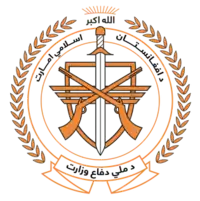 Emblem of the Ministry of Defense of the Islamic Emirate of Afghanistan | |
| Department overview | |
|---|---|
| Jurisdiction | Government of Afghanistan |
| Headquarters | Kabul 34.523938°N 69.186437°E |
| Minister responsible | |
| Deputy Minister responsible | |
| Department executives | |
| Child Department | |
| Website | mod |
 |
|---|
|
|
Democratic Republic of Afghanistan period
From the 30th of April until 9 August 1978, Abdul Qadir succeeded the slain Ghulam Haidar Rasuli as Defense Minister of the DRA, responsible for the Armed Forces of the Democratic Republic of Afghanistan, until being succeeded by General Aslam Watanjar. In 1990 forces loyal to Minister of Defense Shahnawaz Tanai and Hezbi Islami leader Gulbuddin Hekmatyar attempted a fail coup against then President Najibullah. His forces were thwarted by General Aslam Watanjar who was rewarded the post of Minister of Defence.
Watanjar would be the last Minister of Defense of the DRA/ROA.[4][5][6] The government collapsed in 1992.
Islamic Republic period
During the Islamic Republic of Afghanistan (2004–2021), the defense minister was nominated by the President of Afghanistan and the National Assembly made the final approval.
One of the functions of the Defense Ministry during that period was the continuance of disarming insurgent groups, through programmes such as the Afghan New Beginnings Programme (which included the rehabilitation and reintegration of child soldiers). These militant groups coalesced from warlords and former army personnel after the collapse of the Najibullah government in 1992.[7]
List of ministers
| Portrait | Name | Took office | Left office | Political affiliation | |
|---|---|---|---|---|---|
| Sayyid Husayn | January 1929 | March 1929 | Saqqawist | ||
| Purdil Khan | March 1929 | October 1929 | Saqqawist | ||
| Amanul Mulk[lower-alpha 1] | c. 1944 | c. 1946 | Unknown | ||
 |
Mohammad Daoud Khan | 1946 | 1948 | Independent | |
| Abdul Karim Mustaghni | 1973 | 1977 | Republican (from 1974) | ||
| Ghulam Haidar Rasuli | 1977 | April 1978 | Republican | ||
| Abdul Qadir | 27 April 1978 | 17 August 1978 | PDPA | ||
 |
Nur Muhammad Taraki | 17 August 1978[8] | 1 April 1979 | PDPA | |
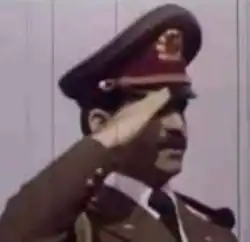 |
Mohammad Aslam Watanjar | 1 April 1979 | 28 July 1979 | PDPA | |
 |
Hafizullah Amin | July 1979 | 27 December 1979[lower-alpha 2] | PDPA | |
| Mohammed Rafie | 28 December 1979 | 1982 | PDPA | ||
| Abdul Qadir | 1982 | September 1984 | PDPA | ||
| Nazar Mohammad | September 1984 | 1986 | PDPA | ||
| Mohammed Rafie | December 1986 | May 1988 | PDPA | ||
| Shahnawaz Tanai | May 1988 | March 1990[lower-alpha 3] | PDPA | ||
 |
Mohammad Aslam Watanjar | March 1990 | April 1992 | PDPA | |
| Ahmad Shah Massoud | 28 April 1992 | 9 September 2001 | Jamiat-e Islami | ||
| Obaidullah Akhund | April 1997 | 9 September 2001 | Taliban | ||
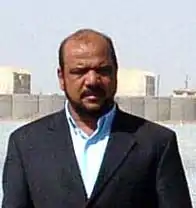 |
Mohammed Fahim | 9 September 2001 | 23 December 2004 | Jamiat-e Islami | |
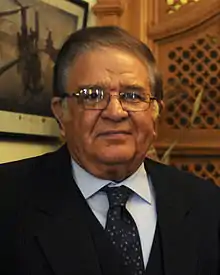 |
Abdul Rahim Wardak | 23 December 2004 | 7 August 2012 | Mahaz-e-Milli-ye Islami | |
| Enayatullah Nazari | 8 August 2012 | 15 September 2012 | Jamiat-e Islami | ||
_(cropped).jpg.webp) |
Bismillah Khan Mohammadi | 15 September 2012 | 24 May 2015 | Jamiat-e Islami | |
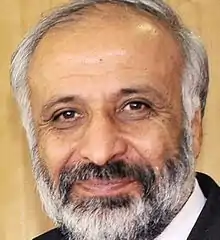 |
Mohammed Masoom Stanekzai | 24 May 2015 | 20 June 2016 | Independent (Military) | |
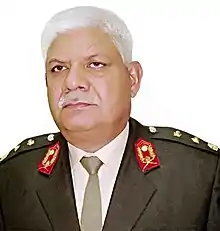 |
Abdullah Habibi | 20 June 2016 | 24 April 2017 | Independent (Military) | |
.jpg.webp) |
Tariq Shah Bahramee | 24 April 2017 | 23 December 2018 | Independent (Military) | |
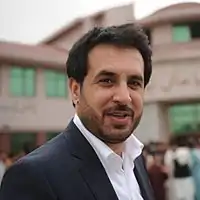 |
Asadullah Khalid | 23 December 2018 | 25 July 2020 | Ittehad-e Islami | |
 |
Shahmahmood Miakhel | 25 July 2020 | 19 March 2021 | Independent (Military) | |
.jpg.webp) |
Yasin Zia | 19 March 2021 | 19 June 2021 | Independent (Military) | |
_(cropped).jpg.webp) |
Bismillah Khan Mohammadi | 19 June 2021[10] | 15 August 2021 | Jamiat-e Islami | |
| Abdul Qayyum Zakir (acting) |
24 August 2021 | 7 September 2021 | Taliban | ||
 |
Mullah Yaqoob (acting) |
7 September 2021[11] | Incumbent | Taliban | |
Notes
- Rebel defence minister in the Eastern Province, during the 1944–47 tribal revolts.
- Assassinated by Soviet special forces during the Operation Storm-333.[9]
- Dismissed following the 1990 Afghan coup d'état attempt.
References
- "د اسلامي امارت په تشکیلاتو کې نوي کسان پر دندو وګومارل شول". باختر خبری آژانس. October 4, 2021.
- "سخنگوی وزارت دفاع ملی معرفی شد | وزارت دفاع ملی". mod.gov.af.
- "Afghanistan gets 'mini-Pentagon' as troops struggle". Associated Press. June 12, 2015. Retrieved February 1, 2016.
- Burns, John F. (10 May 1990). "Kabul Journal; in Power Still, Afghan Can Thank His 4-Star Aide". The New York Times.
- Crossette, Barbara (21 March 1990). "Failed Kabul Coup Changes Opinions". The New York Times.
- "Archives". Los Angeles Times.
- Bhatia, Michael; Sedra, Mark (2008). Afghanistan, Arms and Conflict: Armed groups, disarmament, and security in a postwar society. Abingdon: Routledge. pp. 122–123. ISBN 978-0-415-47734-5.
- Bradsher, Harry (1999). Afghan Communism and Soviet Intervention. Oxford University Press. pp. 35–36. ISBN 0195790170.
- "How Soviet troops stormed Kabul palace". BBC. 27 December 2009. Retrieved 3 August 2021.
- "Afghan president replaces security ministers amid Taliban advance". 2021-06-19.
- "Taliban announce new government for Afghanistan". BBC News. 2021-09-07. Archived from the original on 2021-09-07. Retrieved 2021-09-07.
External links
- Official site
- د ملي دفاع وزارت - وزارت دفاع ملی on Twitter (English: Ministry of Defense)